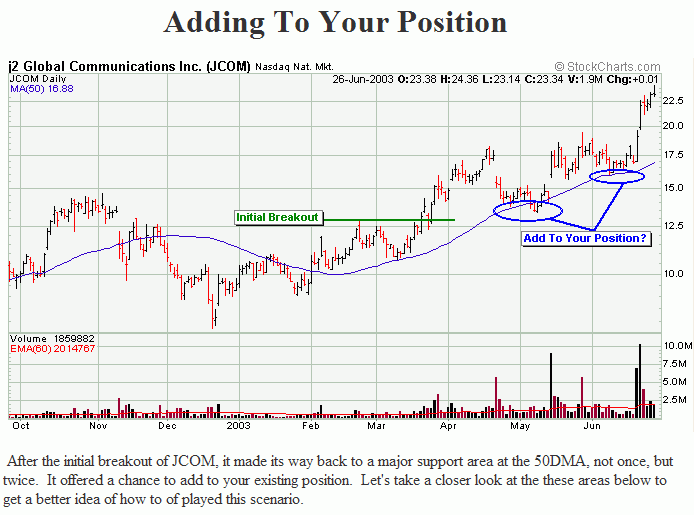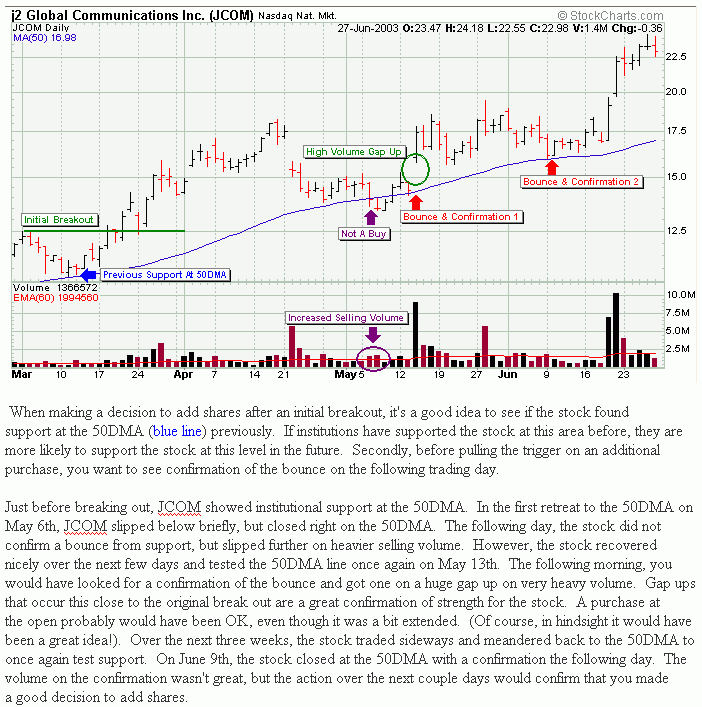Ok, the moment of truth. Your exhaustive search has narrowed your focus to a select group of outstanding companies with exploding earnings and sales with smooth chart patterns indicating strong institutional demand. The market is bullish and you are eager to put your hard earned money to work.
A Word About Overhead Resistance
With each new bull market, new leaders emerge to lead the market. These companies are often found in technology, biotech, leisure and retail. When making your final purchase decision try and focus on stocks breaking out to all time highs. Former leaders will rarely be the biggest winner in the next round of a bull market. There are a few reasons for this. One is due to the impact of overhead resistance. What happens is that people who purchased at a previous high will usually sell once the stock reaches their buy point so they can break even and move on. Purchasing a stock with overhead resistance will constantly encounter resistance points as it moves higher. Another reason, is that too many people are aware of the former leaders. Remember that the largest price moves occur in companies that Wall St. is unaware of. As Wall St. begins to notice, more institutions initiate positions in the stock, driving up the stock price and providing support at major support levels. Soon after, you’ll probably hear the stock mentioned in financial publications and CNBC, driving the price higher. Of course, as a member of Selfinvestors.com you were in the stock long before the hype:)!! In fact, you are beginning to look for those sell signals which indicate there are few buyers left and the stock is about to go into a correction.
The Initial Purchase
Passing the Pivot
-
The pivot point (buy point)
As previously mentioned in the section regarding bases, your buy point (called the pivot point) is .10 above the top of the handle for the cup with handle base, .10 above the high point for a flat base, and .10 above the middle peak for a double bottom. (See section on Bases for examples) -
Don’t chase a stock
If the stock moves more than 5% past the proper buy point, don’t purchase it as you will increase your odds of getting stopped out. Stocks will retreat back to their pivot point 40% of the time, so there is a decent chance you’ll get a second shot. -
Look for a surge in volume (at least 50% greater than average) as the stock passes its pivot point.
You need to calculate the average trading volume per hour for the stocks you’re watching, so you’ll know if it passes its pivot on large volume. However, don’t give up on a stock if it doesn’t show a surge in volume at the breakout. Volume can increase later in the day (when many institutions and traders trade) and in the following days. As long as the stock is within 5% of the pivot and volume is increasing each day, it’s OK to buy.
EXAMPLE
There are 6.5 hours in a trading day. If a stock trades an average of 650,000 shares per day, divide this number by 6.5 to get the hourly average of shares traded. This particular stock trades on average, 100,000 shares an hour. The next day you notice it passes its pivot point at 8:30am and the volume is 350,000. Do you buy? Yes. At 8:30am, you are two hours into the trading day and the average at this time is 200,000 shares. If the volume at the breakout is 350,000 shares, that’s 75% greater than the average. It’s a sign that institutions are starting to accumulate the stock.
Adding To Your Position
Pyramiding Up
In keeping with the common theme of avoiding what most investors do, the best way to add to a position is by pyramiding up. It’s a fact that stocks making new highs will often move higher and stocks making new lows will generally move lower. Most investors make the mistake of averaging down, meaning they continue to add shares as the stock falls. The problem with this is that you have no way of knowing how far down the stock will go. The goal is capital preservation and this is not the way to preserve capital. If you follow this strategy, it’s only a matter of time before you get hurt
After the breakout, stocks will often times find support at their 50DMA before resuming their advance. It’s at this point where it may be OK to add to your position, provided the following statements are true.
-
The stock has a history of solid fundamentals and is a leader in its industry
-
It broke out of a sound base pattern
-
The market is in a confirmed bull phase
-
The stock has a history of finding support at the 50DMA
Rules for making an additional purchase:
-
Only add to your position on the first two retreats to the 50DMA after a breakout from the base
-
The position added should be considerably less than your initial purchase. If your initial position was 100 shares, consider adding an additional 50 on the first pull back to the 50DMA and 25 on the second pullback.
-
Before making the additional purchase, make sure the stock bounces off the 50DMA with good volume. If the stock doesn’t bounce off the 50DMA convincingly during the trading day, wait for a confirmation of the bounce on the following trading day. This shows the stock is being supported at this level by the institutions.
| Adding Shares Part I | Adding Shares Part II |
 |
 |
Time to Form Another Base
After advancing 30% or more from a previous base, a stock will eventually begin to carve out another base in order to digest it’s gains and shake out the weak holders in preparation for another advance. This correction could be anywhere from 15-50% depending on the the strength of the stock and the health of the overall market.
-
Many investors like to hold their position through the next base, adding more shares as the stock breaks out from the next base. If you are an active trader, it may be more profitable to sell your position as the stock begins to break down and form a new base and put the proceeds to work in another high quality stock that is breaking out. You can always come back to the stock after it’s formed the next base and surged past a buy point.
-
BE CAREFUL OF 3rd and 4th Stage Bases.. they are more prone to failure!